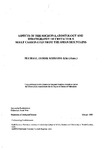ASPECTS OF THE MICROPALAEONTOLOGY AND STRATIGRAPHY OF CRETACEOUS SHELF CARBONATES FROM THE OMAN MOUNTAINS
| dc.contributor.author | SIMMONS, MICHAEL DEREK | |
| dc.contributor.other | School of Geography, Earth and Environmental Sciences | en_US |
| dc.date.accessioned | 2013-10-04T11:41:06Z | |
| dc.date.available | 2013-10-04T11:41:06Z | |
| dc.date.issued | 1990 | |
| dc.identifier | NOT AVAILABLE | en_US |
| dc.identifier.uri | http://hdl.handle.net/10026.1/2031 | |
| dc.description.abstract |
Five outcrop sections (Wadi Mi'aidin, Wadi Bani Kharus, Jebel Madar, Jebel Madamar and Jebel Salak), exposing Thamama and Wasia Group sediments were sedimentologically logged and sampled. Thin sections of each of the Thamama Group samples were prepared for micropalaeontological and microfacies analysis. The foraminifera, calcareous algae and calpionellids in each sample were recorded in order to provide a means of biostratigraphic subdivision, and together with microfacies analysis and sedimentological observations made in the field, provide a means of elucidating the depositional environments of the Thamama Group in the study area. Correlation between outcrop sections has been attempted using a biozonation scheme developed in the course of this project, and also by graphic correlation techniques. The taxonomy of 39 genera including 56 species of key foraminifera, calcareous algae and calpionellids is reviewed in detail. A complete revision of Cretaceous Middle Eastern lithostratigraphic nomenclature is required. Some recommendations for such a revision are proposed. Within the Thamama Group, 13 biozones/subzones are recognised using the extinction and inception events for key taxa. Both biozonal correlation and graphic correlation demonstrate that most Thamama Group formations are diachronous and may also be condensed at some localities. Biostratigraphic studies demonstrate that in the Central Oman Mountains region the Thamama Group formations are of the following ages: The Rayda Formation is of Early Berriasian age. It possibly extends into the earliest Valanginian at some localities (eg. Wadi Bani Kharus). The Salil Formation is of Berriasian - Valanginian age, possibly Hauterivian in age in its upper part at some localities. The Habshan Formation is of Hauterivian age everywhere, with possible extension into the Late Valanginian in its IOWCT part The Lekhwair Formation is essentially of Hauterivian - Barremian age (often largely Hauterivian). The Kharaib Formation is of typically Late Barremian - Early Aptian age, whilst the Shuaiba Formation is of Early Aptian age. Thamama Group deposition took place on an initially downwarped carbonate ramp, prograding towards the Tethyan Ocean (towards the north and east). Offshore palaeowinds precluded the development of reefs, but an oolitic shoal was located at the margin of the ramp, at least during Hauterivian times. | en_US |
| dc.description.sponsorship | Earth Sciences Resources Institute at University College of Wales, Swansea and University of South Carolina, USA and AMOCO Petroleum Company Limited, Houston, USA | en_US |
| dc.language.iso | en | en_US |
| dc.publisher | University of Plymouth | en_US |
| dc.title | ASPECTS OF THE MICROPALAEONTOLOGY AND STRATIGRAPHY OF CRETACEOUS SHELF CARBONATES FROM THE OMAN MOUNTAINS | en_US |
| dc.type | Thesis | |
| plymouth.version | Full version | en_US |
| dc.identifier.doi | http://dx.doi.org/10.24382/4034 | |
| dc.identifier.doi | http://dx.doi.org/10.24382/4034 |
Files in this item
This item appears in the following Collection(s)
-
01 Research Theses Main Collection
Research Theses Main


